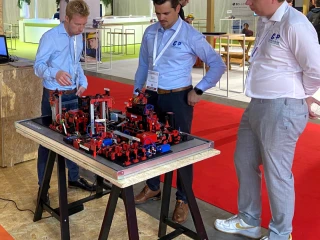Finding the ‘Start’ button
“In the past 12 years, we’ve seen numerous forward-thinking manufacturers experiment with machine vision, IoT, cobots, AI, etc.,” Alexander continues. “And while these investments often yield promising results, there’s often a sense of ‘Ok, now what?’ afterwards. Taking a methodical approach from the start can certainly help keep things moving.”
In most cases, it would look something like this:
1. Establish a common understanding
“Industry 4.0 can mean a lot of things to a lot of people, but it’s important that everyone in your organization is talking about the same things. Make sure you agree on basic definitions and expectations and make a conscious decision about what it will mean for your company, either in the form of an informative masterclass, or a keynote for the leadership team.”
2. Develop a roadmap
“Of course, you can’t just flip the script of your business overnight. Setting the right priorities is the key to a smooth transition. Also, keep in mind that you’ll likely be working with a combination of old and new processes and technologies for a while. This is what’s called ‘organizational ambidexterity’. Your Industry 4.0 roadmap will be a balancing act. On the one hand, you’ll move forward towards your predefined vision, with new systems, processes, a new organization, and set priorities. On the other hand, you’ll still have to take into account legacy systems and processes, and an organization that is currently equipped to thrive in Industry 3.0.”
3. Adjust the course where needed
“Technology is changing all the time, and what seemed impossible yesterday is suddenly commonplace today. On top of that, Industry 4.0 isn’t happening in a vacuum: the economic, cultural, and environmental contexts are constantly shifting as well. Given all that, it wouldn’t make sense to develop a static roadmap and then cling to it for the next 5 to 10 years. Instead, you need to re-evaluate the plotted course at least once every year to account for any important changes.”
At the same time, however, Alexander stresses the importance of holding on to your KPIs. “Many companies let go of their objectives after a while, but we always encourage them to hold on to them as long as possible. While it’s okay to reconsider them along with your roadmap, these objectives provide important feedback on how far along you are on your journey and which adaptation are needed, both technological and organizational, to maximize the return on Industry 4.0 investments. For this, solid governance is absolutely crucial.”



